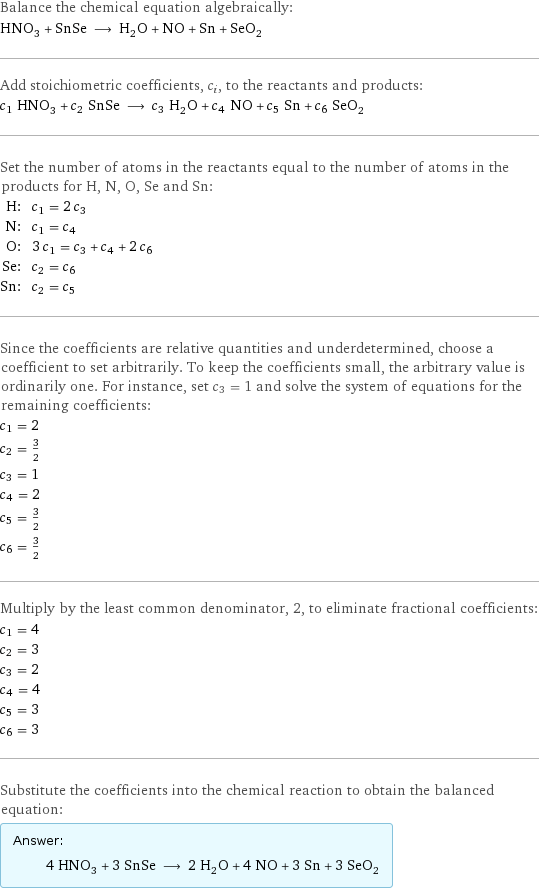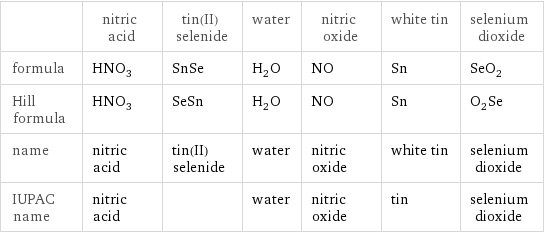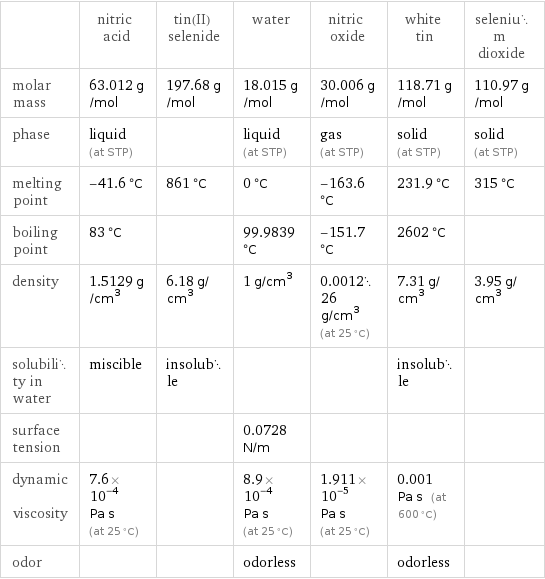Input interpretation

HNO_3 nitric acid + SnSe tin(II) selenide ⟶ H_2O water + NO nitric oxide + Sn white tin + SeO_2 selenium dioxide
Balanced equation

Balance the chemical equation algebraically: HNO_3 + SnSe ⟶ H_2O + NO + Sn + SeO_2 Add stoichiometric coefficients, c_i, to the reactants and products: c_1 HNO_3 + c_2 SnSe ⟶ c_3 H_2O + c_4 NO + c_5 Sn + c_6 SeO_2 Set the number of atoms in the reactants equal to the number of atoms in the products for H, N, O, Se and Sn: H: | c_1 = 2 c_3 N: | c_1 = c_4 O: | 3 c_1 = c_3 + c_4 + 2 c_6 Se: | c_2 = c_6 Sn: | c_2 = c_5 Since the coefficients are relative quantities and underdetermined, choose a coefficient to set arbitrarily. To keep the coefficients small, the arbitrary value is ordinarily one. For instance, set c_3 = 1 and solve the system of equations for the remaining coefficients: c_1 = 2 c_2 = 3/2 c_3 = 1 c_4 = 2 c_5 = 3/2 c_6 = 3/2 Multiply by the least common denominator, 2, to eliminate fractional coefficients: c_1 = 4 c_2 = 3 c_3 = 2 c_4 = 4 c_5 = 3 c_6 = 3 Substitute the coefficients into the chemical reaction to obtain the balanced equation: Answer: | | 4 HNO_3 + 3 SnSe ⟶ 2 H_2O + 4 NO + 3 Sn + 3 SeO_2
Structures

+ ⟶ + + +
Names

nitric acid + tin(II) selenide ⟶ water + nitric oxide + white tin + selenium dioxide
Equilibrium constant
![Construct the equilibrium constant, K, expression for: HNO_3 + SnSe ⟶ H_2O + NO + Sn + SeO_2 Plan: • Balance the chemical equation. • Determine the stoichiometric numbers. • Assemble the activity expression for each chemical species. • Use the activity expressions to build the equilibrium constant expression. Write the balanced chemical equation: 4 HNO_3 + 3 SnSe ⟶ 2 H_2O + 4 NO + 3 Sn + 3 SeO_2 Assign stoichiometric numbers, ν_i, using the stoichiometric coefficients, c_i, from the balanced chemical equation in the following manner: ν_i = -c_i for reactants and ν_i = c_i for products: chemical species | c_i | ν_i HNO_3 | 4 | -4 SnSe | 3 | -3 H_2O | 2 | 2 NO | 4 | 4 Sn | 3 | 3 SeO_2 | 3 | 3 Assemble the activity expressions accounting for the state of matter and ν_i: chemical species | c_i | ν_i | activity expression HNO_3 | 4 | -4 | ([HNO3])^(-4) SnSe | 3 | -3 | ([SnSe])^(-3) H_2O | 2 | 2 | ([H2O])^2 NO | 4 | 4 | ([NO])^4 Sn | 3 | 3 | ([Sn])^3 SeO_2 | 3 | 3 | ([SeO2])^3 The equilibrium constant symbol in the concentration basis is: K_c Mulitply the activity expressions to arrive at the K_c expression: Answer: | | K_c = ([HNO3])^(-4) ([SnSe])^(-3) ([H2O])^2 ([NO])^4 ([Sn])^3 ([SeO2])^3 = (([H2O])^2 ([NO])^4 ([Sn])^3 ([SeO2])^3)/(([HNO3])^4 ([SnSe])^3)](../image_source/c5cc679ae61afea9c446ae526b1ea893.png)
Construct the equilibrium constant, K, expression for: HNO_3 + SnSe ⟶ H_2O + NO + Sn + SeO_2 Plan: • Balance the chemical equation. • Determine the stoichiometric numbers. • Assemble the activity expression for each chemical species. • Use the activity expressions to build the equilibrium constant expression. Write the balanced chemical equation: 4 HNO_3 + 3 SnSe ⟶ 2 H_2O + 4 NO + 3 Sn + 3 SeO_2 Assign stoichiometric numbers, ν_i, using the stoichiometric coefficients, c_i, from the balanced chemical equation in the following manner: ν_i = -c_i for reactants and ν_i = c_i for products: chemical species | c_i | ν_i HNO_3 | 4 | -4 SnSe | 3 | -3 H_2O | 2 | 2 NO | 4 | 4 Sn | 3 | 3 SeO_2 | 3 | 3 Assemble the activity expressions accounting for the state of matter and ν_i: chemical species | c_i | ν_i | activity expression HNO_3 | 4 | -4 | ([HNO3])^(-4) SnSe | 3 | -3 | ([SnSe])^(-3) H_2O | 2 | 2 | ([H2O])^2 NO | 4 | 4 | ([NO])^4 Sn | 3 | 3 | ([Sn])^3 SeO_2 | 3 | 3 | ([SeO2])^3 The equilibrium constant symbol in the concentration basis is: K_c Mulitply the activity expressions to arrive at the K_c expression: Answer: | | K_c = ([HNO3])^(-4) ([SnSe])^(-3) ([H2O])^2 ([NO])^4 ([Sn])^3 ([SeO2])^3 = (([H2O])^2 ([NO])^4 ([Sn])^3 ([SeO2])^3)/(([HNO3])^4 ([SnSe])^3)
Rate of reaction
![Construct the rate of reaction expression for: HNO_3 + SnSe ⟶ H_2O + NO + Sn + SeO_2 Plan: • Balance the chemical equation. • Determine the stoichiometric numbers. • Assemble the rate term for each chemical species. • Write the rate of reaction expression. Write the balanced chemical equation: 4 HNO_3 + 3 SnSe ⟶ 2 H_2O + 4 NO + 3 Sn + 3 SeO_2 Assign stoichiometric numbers, ν_i, using the stoichiometric coefficients, c_i, from the balanced chemical equation in the following manner: ν_i = -c_i for reactants and ν_i = c_i for products: chemical species | c_i | ν_i HNO_3 | 4 | -4 SnSe | 3 | -3 H_2O | 2 | 2 NO | 4 | 4 Sn | 3 | 3 SeO_2 | 3 | 3 The rate term for each chemical species, B_i, is 1/ν_i(Δ[B_i])/(Δt) where [B_i] is the amount concentration and t is time: chemical species | c_i | ν_i | rate term HNO_3 | 4 | -4 | -1/4 (Δ[HNO3])/(Δt) SnSe | 3 | -3 | -1/3 (Δ[SnSe])/(Δt) H_2O | 2 | 2 | 1/2 (Δ[H2O])/(Δt) NO | 4 | 4 | 1/4 (Δ[NO])/(Δt) Sn | 3 | 3 | 1/3 (Δ[Sn])/(Δt) SeO_2 | 3 | 3 | 1/3 (Δ[SeO2])/(Δt) (for infinitesimal rate of change, replace Δ with d) Set the rate terms equal to each other to arrive at the rate expression: Answer: | | rate = -1/4 (Δ[HNO3])/(Δt) = -1/3 (Δ[SnSe])/(Δt) = 1/2 (Δ[H2O])/(Δt) = 1/4 (Δ[NO])/(Δt) = 1/3 (Δ[Sn])/(Δt) = 1/3 (Δ[SeO2])/(Δt) (assuming constant volume and no accumulation of intermediates or side products)](../image_source/6139e9e95975e29c1c96e01649ad26b4.png)
Construct the rate of reaction expression for: HNO_3 + SnSe ⟶ H_2O + NO + Sn + SeO_2 Plan: • Balance the chemical equation. • Determine the stoichiometric numbers. • Assemble the rate term for each chemical species. • Write the rate of reaction expression. Write the balanced chemical equation: 4 HNO_3 + 3 SnSe ⟶ 2 H_2O + 4 NO + 3 Sn + 3 SeO_2 Assign stoichiometric numbers, ν_i, using the stoichiometric coefficients, c_i, from the balanced chemical equation in the following manner: ν_i = -c_i for reactants and ν_i = c_i for products: chemical species | c_i | ν_i HNO_3 | 4 | -4 SnSe | 3 | -3 H_2O | 2 | 2 NO | 4 | 4 Sn | 3 | 3 SeO_2 | 3 | 3 The rate term for each chemical species, B_i, is 1/ν_i(Δ[B_i])/(Δt) where [B_i] is the amount concentration and t is time: chemical species | c_i | ν_i | rate term HNO_3 | 4 | -4 | -1/4 (Δ[HNO3])/(Δt) SnSe | 3 | -3 | -1/3 (Δ[SnSe])/(Δt) H_2O | 2 | 2 | 1/2 (Δ[H2O])/(Δt) NO | 4 | 4 | 1/4 (Δ[NO])/(Δt) Sn | 3 | 3 | 1/3 (Δ[Sn])/(Δt) SeO_2 | 3 | 3 | 1/3 (Δ[SeO2])/(Δt) (for infinitesimal rate of change, replace Δ with d) Set the rate terms equal to each other to arrive at the rate expression: Answer: | | rate = -1/4 (Δ[HNO3])/(Δt) = -1/3 (Δ[SnSe])/(Δt) = 1/2 (Δ[H2O])/(Δt) = 1/4 (Δ[NO])/(Δt) = 1/3 (Δ[Sn])/(Δt) = 1/3 (Δ[SeO2])/(Δt) (assuming constant volume and no accumulation of intermediates or side products)
Chemical names and formulas

| nitric acid | tin(II) selenide | water | nitric oxide | white tin | selenium dioxide formula | HNO_3 | SnSe | H_2O | NO | Sn | SeO_2 Hill formula | HNO_3 | SeSn | H_2O | NO | Sn | O_2Se name | nitric acid | tin(II) selenide | water | nitric oxide | white tin | selenium dioxide IUPAC name | nitric acid | | water | nitric oxide | tin | selenium dioxide
Substance properties

| nitric acid | tin(II) selenide | water | nitric oxide | white tin | selenium dioxide molar mass | 63.012 g/mol | 197.68 g/mol | 18.015 g/mol | 30.006 g/mol | 118.71 g/mol | 110.97 g/mol phase | liquid (at STP) | | liquid (at STP) | gas (at STP) | solid (at STP) | solid (at STP) melting point | -41.6 °C | 861 °C | 0 °C | -163.6 °C | 231.9 °C | 315 °C boiling point | 83 °C | | 99.9839 °C | -151.7 °C | 2602 °C | density | 1.5129 g/cm^3 | 6.18 g/cm^3 | 1 g/cm^3 | 0.001226 g/cm^3 (at 25 °C) | 7.31 g/cm^3 | 3.95 g/cm^3 solubility in water | miscible | insoluble | | | insoluble | surface tension | | | 0.0728 N/m | | | dynamic viscosity | 7.6×10^-4 Pa s (at 25 °C) | | 8.9×10^-4 Pa s (at 25 °C) | 1.911×10^-5 Pa s (at 25 °C) | 0.001 Pa s (at 600 °C) | odor | | | odorless | | odorless |
Units
